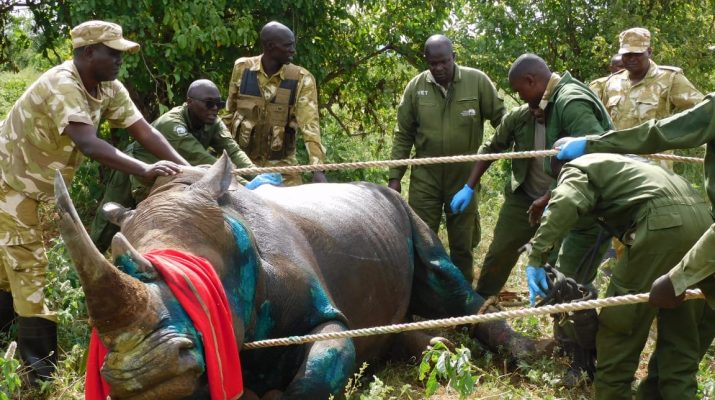By Alice Njeri
A critically endangered black rhino bull is on the road to recovery after suffering multiple life-threatening injuries in a violent territorial clash inside Meru National Park.
The Kenya Wildlife Service (KWS), in partnership with veterinary teams and conservation stakeholders, launched an urgent field operation to save the animal, highlighting the high-stakes reality of wildlife conservation in Kenya.
The incident unfolded deep within the park, where the rhino was found with serious wounds, including a deep leg injury that had left him severely lame and vulnerable.
“Territorial fights among rhinos can be brutal and for a species already endangered, even one injury can be life-threatening,” said KWS through a statement posted on X.
Rhino bulls are known to be fiercely territorial, and battles for dominance can often result in grave injuries or even death. Given the rhino’s critical condition, time was of the essence.
KWS rangers, supported by aerial surveillance from conservation partner Sheldrick Wildlife Trust, tracked the injured bull for hours through dense bush. They finally located him resting in a stream.
The Meru and Mount Kenya Mobile Veterinary Units responded swiftly. With the assistance of the Sheldrick Trust’s air support team, the rhino was safely darted from above, sedated, and treated on-site.
“The rhino was darted from the air, treated on-site, and stabilized. All wounds were meticulously cleaned, debrided with hydrogen peroxide, irrigated with an iodine solution, and dressed with green clay,” continued KWS.
In addition, the rhino received a combination of long-acting broad-spectrum antibiotics, anti-inflammatory medication and metabolic stimulants to aid the healing process.
Rhinos are among the most endangered mammals in the world, with black rhinos listed as critically endangered due to decades of poaching and habitat loss.
KWS emphasized the importance of teamwork in ensuring the rhino’s survival.
“Thanks to the unwavering dedication of KWS vets and our partners, who work around the clock to protect Kenya’s wildlife, he’s now on the path to healing and is being closely monitored to ensure his recovery stays on track,” concluded KWS.

